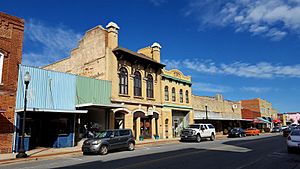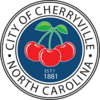Cherryville, North Carolina facts for kids
Quick facts for kids
Cherryville, North Carolina
|
|||
|---|---|---|---|
 |
|||
|
|||
| Nickname(s):
Cville
|
|||

Location in the US state of North Carolina
|
|||
| Country | |||
| State | |||
| County | Gaston | ||
| Incorporated | 1881 | ||
| Area | |||
| • Total | 5.53 sq mi (14.33 km2) | ||
| • Land | 5.52 sq mi (14.30 km2) | ||
| • Water | 0.01 sq mi (0.03 km2) | ||
| Elevation | 955 ft (291 m) | ||
| Population
(2020)
|
|||
| • Total | 6,078 | ||
| • Density | 1,101.09/sq mi (425.10/km2) | ||
| Time zone | UTC−5 (Eastern (EST)) | ||
| • Summer (DST) | UTC−4 (EDT) | ||
| ZIP code |
28021
|
||
| Area code | 704 | ||
| FIPS code | 37-12340 | ||
| GNIS feature ID | 2404040 | ||
Cherryville is a city in Gaston County, North Carolina, in the United States. About 6,000 people live there. It's located about 38 miles (61 km) west of Charlotte.
Every New Year's Day, a group called the New Year's Shooters celebrates the area's German history. They do this by chanting and firing muskets. It's a special tradition that starts the year with a bang!
Contents
Cherryville's Location and Land
Cherryville is in Cherryville Township. It sits at an elevation of about 955 feet (291 meters) above sea level. The city covers an area of about 5.53 square miles (14.33 square kilometers). Most of this area is land, with only a tiny bit of water.
The city is located where water flows into three different river systems. Water from the western part of Cherryville flows into Muddy Creek, which is part of the Broad River. Water from the north side goes into Indian Creek. And water from the south side flows into Beaverdam Creek. Both Indian Creek and Beaverdam Creek are branches of the South Fork Catawba River.
A Look Back at Cherryville's History
Early Settlers and the Name "White Pine"
In the late 1700s, families from Germany, the Netherlands, and Scotland-Ireland moved south from Colony of Pennsylvania. They settled in the area that is now Cherryville. The King of Great Britain, George III, gave out land grants here as early as 1768.
By 1792, the settlement was known as "White Pine." A small village started to grow where two important roads met. One road went from Morganton to Charleston. The other was the Old Post Road, which connected Salisbury, North Carolina, and Spartanburg, South Carolina.
How Cherryville Got Its Name
In 1862, a railroad reached White Pine. This railroad was called the Wilmington, Charlotte and Rutherford Railroad. It later became the Carolina Central Railroad. The railroad's construction stopped in Cherryville during the Civil War. This made Cherryville the western end of the railroads in North Carolina for a while.
When the railroad building started again, trains continued past Cherryville. The town became a stop where trains could get water and coal. A local person had planted cherry trees along the railroad tracks. Train engineers started calling the settlement "Cherryville" because of these trees. The town officially became a city with this name in 1881.
From Farms to Factories
For many years, farming was the main way people made a living in Cherryville. But in the late 1800s, the textile industry began to grow. Cherryville's first cotton mill opened in 1891. Soon, three more mills opened. By the early 1900s, Cherryville had become an industrial town with about a thousand people.
Eventually, 13 different mills opened in Cherryville. These included places like Vivian Manufacturing Company and Carlton Yarn Mills. All of these textile factories have since closed down.
A Big Trucking Company
In 1932, a trucking company started in Cherryville with just one truck. It hauled produce from Florida to Cherryville. This company grew into one of the largest freight carriers in the country! It was known as Carolina Freight Carriers Corporation. After more than 60 years, another company bought Carolina Freight in 1995, and its operations moved away from Cherryville.
Historic Places
The Beam's Shell Service Station and Office is a historic building in Cherryville. It was added to the National Register of Historic Places in 1997.
People of Cherryville
The city's population has grown over the years. In 1900, about 1,000 people lived here. By 2020, the population had reached 6,078 people.
Most people in Cherryville are White (78%). About 10% are Black or African American. Around 6.6% of the people are Hispanic or Latino.
What Cherryville Makes and Does
Cherryville has several important employers. Keystone Powdered Metal Company makes parts for cars. FleetNet America helps maintain large vehicle fleets. Bradington-Young Furniture Company makes sofas, chairs, and recliners. Other companies make things like pre-fabricated homes and polyurethane products.
Many people also work in government, schools, and construction. The public school system employs many people locally. The City of Cherryville government also provides jobs. Rutherford Electric Membership Cooperative and Beam Construction Company are also big employers.
Schools in Cherryville
Public schools in Cherryville are part of the Gaston County Schools system. These include:
- Cherryville Elementary School (grades K-3)
- William Blaine Beam Intermediate School (grades 4–5)
- John Chavis Middle School (grades 6–8)
- Cherryville High School (grades 9-12)
The Cherryville Branch of the Gaston County Public Library serves the community. It's a great place to find books and learn new things!
Churches in Cherryville
The first church in Cherryville was Saint John's Evangelical Lutheran Church. It was started in 1881, the same year the town became a city. Many other churches have been established in Cherryville since then. These include United Methodist, Baptist, Presbyterian, and Wesleyan churches.
Fun Places to Visit
The Cherryville Historical Museum teaches about the history of the Cherryville area. It's open to the public on certain days each week.
The C. Grier Beam Truck Museum shows the history of freight trucking. It's located in the old Beam's Shell Service Station and Office. This building is also on the National Register of Historic Places.
The 1922 Noah Benjamin Kendrick House is another historic property in Cherryville.
If you like golf, the semi-private Cherryville Country Club has a nine-hole golf course. Rudisill Stadium is the biggest sports place in Cherryville. It's used for many community events throughout the year.
Notable People from Cherryville
Many interesting people have come from Cherryville, including:
- Debbie A. Clary (born 1959), a politician who served in the North Carolina government.
- Tony Cloninger (1940–2018), a former Major League Baseball pitcher.
- Fred Durst (born 1970), a singer, rapper, and film director.
- Trentavis Friday (born 1995), a track and field athlete known for sprinting.
- Patrick McHenry (born 1975), a member of the U.S. House of Representatives.
- Jack Tatum (1948–2010), a former NFL player.
- George Wilson (1925–1974), a former Major League Baseball outfielder.
See also
 In Spanish: Cherryville (Carolina del Norte) para niños
In Spanish: Cherryville (Carolina del Norte) para niños




